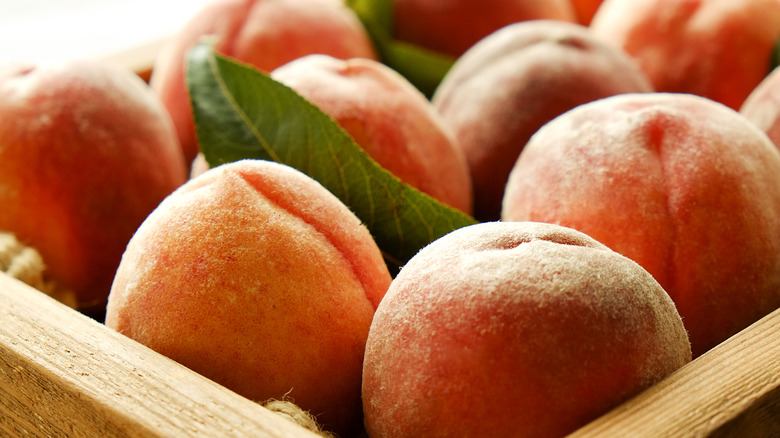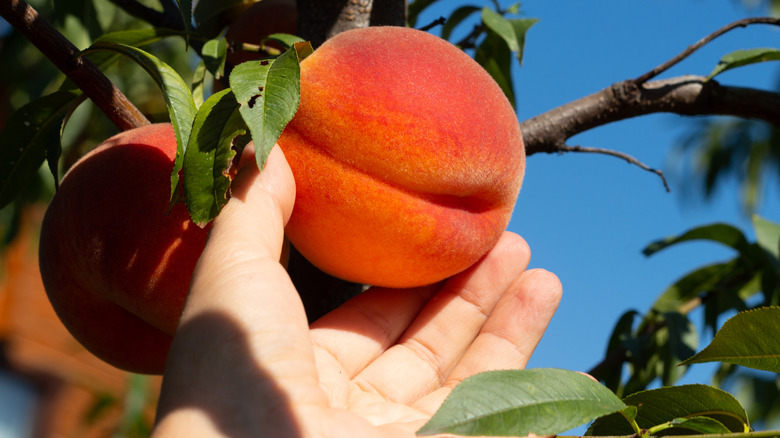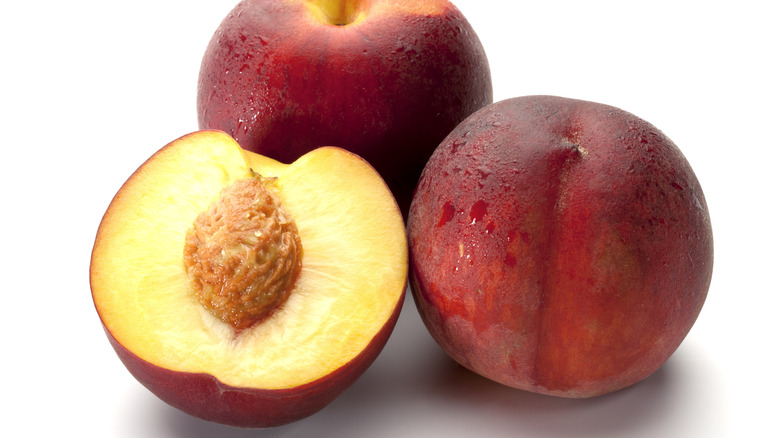Clingstone Vs Freestone Peaches: The Texture Difference Explained
Fresh, seasonal peaches are some of summer's most beloved treats. When the weather is at its hottest, peaches are ready for picking. Sweet, juicy, and tart, they are a beloved and highly cherished fruit for eating right off the tree or in dozens of sweet and savory recipes. Famous in places like Georgia, South Carolina, and California, peaches can be and are grown in many states across America. They are characterized by their fuzzy skin and the large pit in the middle, making them one of several fruits known as stone fruits.
If you're a fan of peaches, you've likely observed that occasionally, the sweet flesh separates from the pit effortlessly upon cutting or biting, leaving the pit completely clean. Yet, there are instances when the fruit clings to the pit like super glue got a hold of it. What gives? Most of the time, this has little to do with ripeness and everything to do with whether the peach is categorized as a clingstone or freestone. You can't tell the difference just by appearance, so you'll only know which one you've got once you reach the pit. However, the ease with which the flesh detaches from the pit isn't the only differing factor between these varieties. One tends to be juicier, while the other appeals to those who prefer a firm fruit.
The succulent world of clingstone peaches
As the name implies, clingstone peaches are the variety in which the peach flesh clings to the pit, or stone. They tend to have very soft flesh and a lot of juice. If you ever bite into a peach and juice immediately begins to run down your chin or hand, you've probably picked up a clingstone. In general, clingstone peaches are smaller than freestones and as early bloomers, they will be among the first peaches available in markets at the onset of the peach season.
The way they adhere to the pit, making them challenging to slice cleanly, makes clingstone peaches ideal for eating fresh. That said, they are among the sweetest of peaches, so they're also a great choice for sweet desserts and jams. It's just going to take a little elbow grease to release the hold the flesh has on the pits. There are dozens of varieties of peaches, and most of them are not classified as clingstones. At supermarkets, it's going to be very difficult to find out which kind of peach is being sold, but farmers' market purveyors and private growers should be able to tell you about the variety and whether it's a clingstone.
The sweet freedom of freestone peaches
Lots of people tend to prefer freestone peaches because they're easy to eat and cut. The peach flesh simply comes right off the pit with much less effort than that of clingstones. Fortunately, most varieties fall into the freestone category. The fruit of a freestone peach is going to be a little firmer and less juicy than a clingstone peach, but it should still be just as sweet and delicious. Freestones, like their clingstone counterparts, are suitable for both eating fresh and using in cooking or baking. In terms of superiority, what truly counts is the ripeness of a peach. If you're planning to bake half a dozen peach cobblers and are partial to freestones, but stumble upon clingstones that smell, look, and taste better, choose the latter. They might be more difficult to process, but always prioritizing the better flavor will prove to be worth it in the end.
Freestones are likely to be more abundant as the peach season progresses, unlike clingstones that appear early. This, of course, depends on factors such as variety, location, and crop health. Regardless of the stone type, if you love peaches, choose them based on your sense of smell, sight, and touch. A fresh, ripe peach should have a gorgeous aroma, very little to no green skin, and the flesh shouldn't be rock hard. Fruit clinging to the pit is an insignificant price to pay for a perfectly sweet peach.



